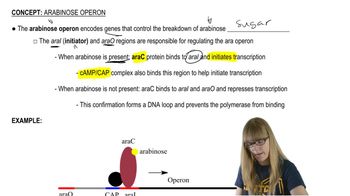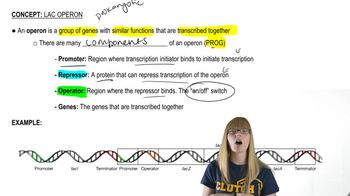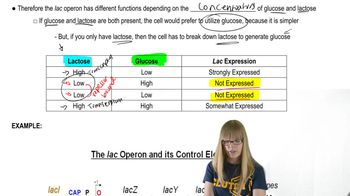Table of contents
- 1. Introduction to Genetics51m
- 2. Mendel's Laws of Inheritance3h 37m
- 3. Extensions to Mendelian Inheritance2h 41m
- 4. Genetic Mapping and Linkage2h 28m
- 5. Genetics of Bacteria and Viruses1h 21m
- 6. Chromosomal Variation1h 48m
- 7. DNA and Chromosome Structure56m
- 8. DNA Replication1h 10m
- 9. Mitosis and Meiosis1h 34m
- 10. Transcription1h 0m
- 11. Translation58m
- 12. Gene Regulation in Prokaryotes1h 19m
- 13. Gene Regulation in Eukaryotes44m
- 14. Genetic Control of Development44m
- 15. Genomes and Genomics1h 50m
- 16. Transposable Elements47m
- 17. Mutation, Repair, and Recombination1h 6m
- 18. Molecular Genetic Tools19m
- 19. Cancer Genetics29m
- 20. Quantitative Genetics1h 26m
- 21. Population Genetics50m
- 22. Evolutionary Genetics29m
12. Gene Regulation in Prokaryotes
Lac Operon
Problem 2d
Textbook Question
Transcriptional regulation of operon gene expression involves the interaction of molecules with one another and of regulatory molecules with segments of DNA. In this context, define and give an example of each of the following: promoter
 Verified step by step guidance
Verified step by step guidance1
Understand that a promoter is a specific DNA sequence that acts as a binding site for RNA polymerase, initiating transcription of a gene or operon.
Recognize that promoters are typically located upstream of the gene they regulate, often containing specific sequences like the TATA box in eukaryotes or the -10 and -35 regions in prokaryotes.
Consider the role of promoters in transcriptional regulation, where they determine the site of transcription initiation and influence the frequency of transcription.
Identify an example of a promoter: In the lac operon of E. coli, the promoter is the site where RNA polymerase binds to initiate transcription of the operon genes involved in lactose metabolism.
Reflect on how mutations in promoter regions can affect gene expression by altering the binding efficiency of RNA polymerase or regulatory proteins, leading to changes in transcription levels.
Recommended similar problem, with video answer:
 Verified Solution
Verified SolutionThis video solution was recommended by our tutors as helpful for the problem above
Video duration:
1mPlay a video:
Was this helpful?
Key Concepts
Here are the essential concepts you must grasp in order to answer the question correctly.
Promoter
A promoter is a specific DNA sequence located upstream of a gene that serves as the binding site for RNA polymerase and transcription factors. It is essential for initiating the transcription of the gene into messenger RNA (mRNA). For example, the lac promoter in the lac operon of E. coli is responsible for the transcription of genes involved in lactose metabolism.
Recommended video:
Guided course

Bacteriophage Regulation
Transcription Factors
Transcription factors are proteins that bind to specific DNA sequences, including promoters, to regulate the transcription of genes. They can act as activators or repressors, influencing the rate of gene expression. For instance, the CAP (catabolite activator protein) enhances the transcription of the lac operon in the presence of cAMP, promoting lactose utilization when glucose levels are low.
Recommended video:
Guided course

Eukaryotic Transcription
Operon
An operon is a cluster of genes under the control of a single promoter and regulatory elements, allowing coordinated expression of genes with related functions. In prokaryotes, operons enable efficient regulation of metabolic pathways. The lac operon, for example, contains genes that encode proteins necessary for the uptake and breakdown of lactose, all regulated together in response to environmental conditions.
Recommended video:
Guided course

Arabinose Operon

 4:27m
4:27mWatch next
Master Lac Operon Overview with a bite sized video explanation from Kylia Goodner
Start learning



